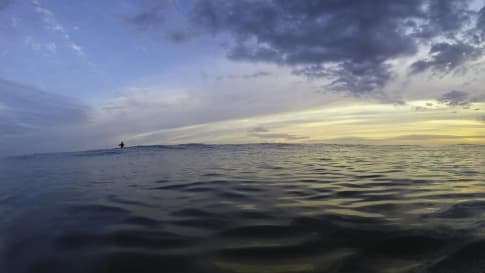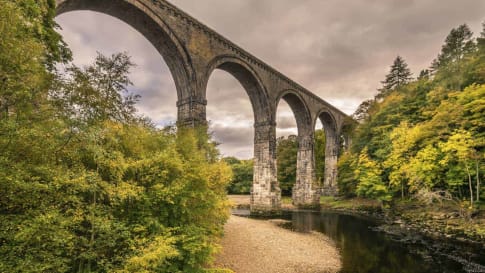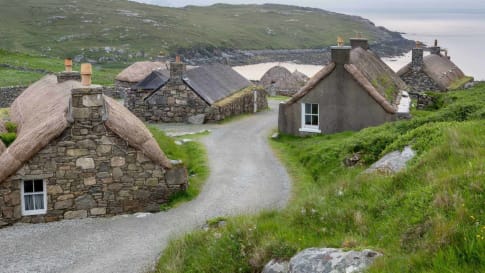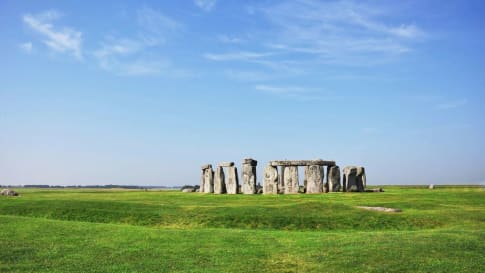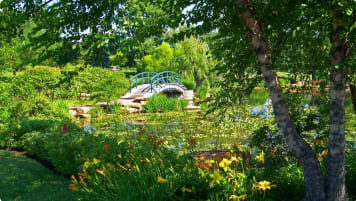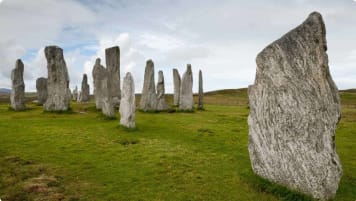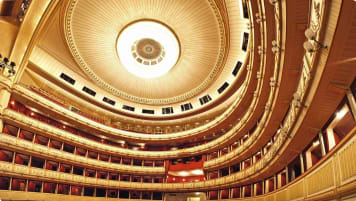Seven Ages of Britain, snapshots of Britain through the ages.
This guided small group tour starts in Scotland and finishes in England. On Orkney we have a day tour to the UNESCO World heritage site, Skara Brae, before travelling to city of York. Your tour leader continues to share the history from the Neolithic to the Victorian era. The tour concludes in the capital city, London.
From A$16,895AUD

Highlights
- 1. Walk in the footsteps of the Romans on Hadrian’s Wall and read letters from real Romans uncovered in the peaty soil of Vindolanda.
- 2. Explore the Holy Isle, an important centre for Celtic Christianity from the 6th century AD, before it was destroyed by Viking invaders.
- 3. Be amazed by the splendour of Norman cathedrals in Durham, York, Ely and Norwich.
- 4. Journey back in time as you walk through the Victorian tunnel under Newcastle, built to transport coal but used as a bomb shelter during WWII.
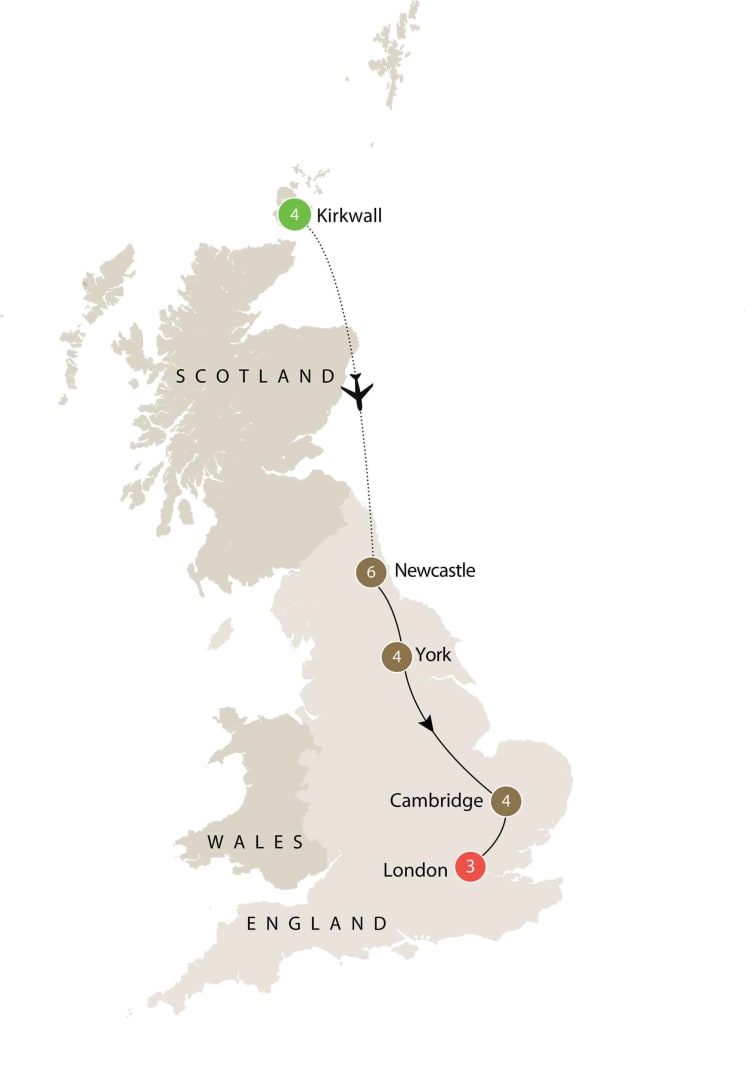
Departure Dates
| Departure Date | Price |
|---|---|
| 23 August 2025 Ends 13 September 2025 • 22 days A$16,895 Twin A$18,710 Single Available | Selected |
| 13 April 2026 Ends 04 May 2026 • 22 days A$17,450 Twin A$20,350 Single Available | |
| 22 August 2026 Ends 12 September 2026 • 22 days A$17,450 Twin A$20,350 Single Available | |
| 12 April 2027 Ends 03 May 2027 • days A$17,450 Twin A$20,350 Single Available | |
| 21 August 2027 Ends 11 September 2027 • days A$17,450 Twin A$20,350 Single Available |
Seven Ages of Britain, snapshots of Britain through the ages.
If you are a senior traveller with an interest in history and in the way life has changed over the ages, this might just be the tour for you. The tour concentrates on just seven periods in Britain’s long history, and we explore five locations to reveal what each age has to tell us about life for the ordinary person making ends meet, and members of the nobility living in luxury. This is a small group tour for up to 16 travellers. The group is typically drawn from mature and senior travellers, couples and solo travellers.
Our small group tour of British history allows the active senior to spend three weeks gaining an overview of the many changes undergone by the peoples of the British Isles over a 5000-year period. Britain has a long and complicated history but, for the purpose of this tour, we concentrate on just seven periods for particular investigation.
We look particularly at the following ages:
- Neolithic Age
- impact of the Romans
- arrival of the Saxons
- era of the Vikings
- Norman conquest and rule
- Tudor period and the Age of Enlightenment
- impact of the Victorians and the Industrial Age
This tour takes us from the islands of Orkney, in the far north, to London in the south. We examine seven formative periods of British history in an attempt to discover how the past informs the present. We begin in Orkney, Scotland, where we stroll through some of Europe’s best-preserved Neolithic and Viking monuments, before flying south to Newcastle, England and then travelling on through the quaint villages and hidden gems of York and Cambridge, before ending in London for a further exploration of the wonders of the United Kingdom's capital.
Obviously, in such a short time, our exploration will only be an overview--something, perhaps, to whet the appetite for further study, or future tours concentrating on just one of our seven ages.
Join us on this 22-day tour which is an exciting addition to our collection of Scotland and England tours for seniors. Senior travel has never been more fun; experience history and beautiful landscapes and scenery with like-minded people on this unique vacation. As always, couples and solo travellers are welcome, and similar to other Odyssey Traveller tours, you will be accompanied at all times by a Program Leader and local guides.
Articles published by Odyssey Traveller to assist you on your visit to Britain
The following list of articles published by Odyssey Traveller for mature aged and senior travellers to maximise their knowledge and enjoyment of Britain when visiting:
- Why Join a Small Group Tour?
- Ten Things We Never Knew About London
- Exploring Newcastle upon Tyne
- Traveller's Guide to Medieval England
- Life in the Medieval British Village
- Victorian England Rural Life
- Queen Victoria's Britain
- New Discoveries About Britain's Stone Circles
- Dry Stone Walls: An Alternative History of the British Isles
- British Village Icons: Pubs and Cottages
- Roman Roads in Britain
Click here to see our other articles of the British Isles.
External Articles to assist you on your visit to Britain
- Ten books about Walking in Britain from the Guardian
- UNESCO World Heritage sites of Britain
- Neolithic Britain (British Museum)
- Guide to Neolithic Britain (Country File)
- History: Middle Ages (BBC)
- An Introduction to Medieval England (English Heritage)
- The top 9 UK countryside breaks for 2018 (Country Living)
- 21 Most Beautiful Villages in the UK (Travel Away)
- These are the top 10 most picturesque towns, villages and cities in England (House Beautiful)
Other Odyssey Tours
Seven Ages of Britain is only one of many tours of Britain tours for seniors offered by Odyssey Traveller. You can also research England and Scotland further. For more details of this tour, click the ‘Top 5’ or ‘Itinerary’ buttons above! If you’re keen to experience this tour, please call or send an email. Or, to book, simply fill in the form on the right hand side of this page.
Gallery
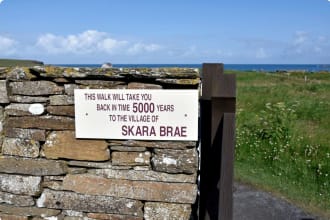
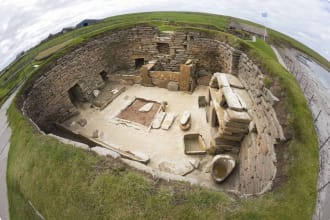
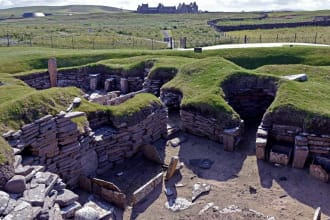
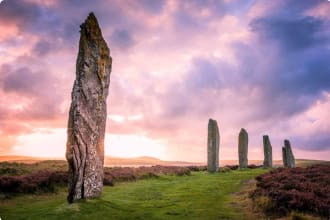
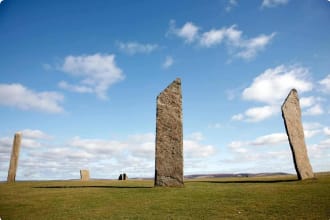
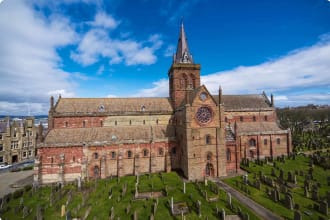
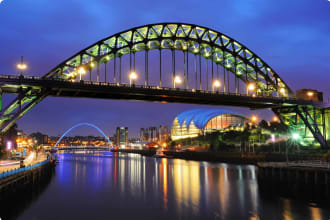
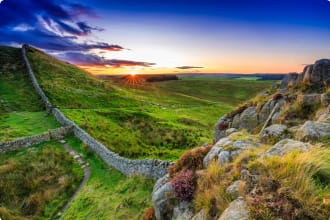
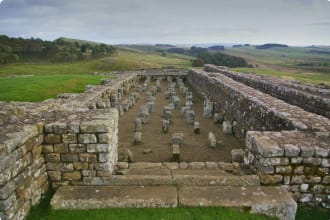
Itinerary
22 days
Day 1: Kirkwall
Today the tour begins in the ancient Norse town of Kirkwall, Orkney’s capital and largest town. In the afternoon meet the rest of the group, and your tour leader, at the hotel where we stay for the next four nights.
Orkney, just north of the Scottish mainland, has a long history of human occupation. It is here that Skara Brae, one of Europe’s best preserved Neolithic village, was uncovered by a storm in 1850. The island allows us to explore 5000 years of history, all concentrated over a relatively small area.
Our welcome dinner this evening will be in a local restaurant.
Day 2: Kirkwall - Stenness - Skara Brae - Kirkwall
This morning we drive to Maeshowe Chambered Cairn for a guided tour of what has been called one of the finest Neolithic buildings in Europe. This fine chambered tomb dates back over 5000 years and is famously aligned with the setting of the winter sun. The tomb contains a fine collection of later Norse runic inscriptions as well as Neolithic carvings.
On our way to visit the Neolithic village of Skara Brae we will stop to visit the standing stones at Stenness as well as the nearby Ring of Brodgar. Radio carbon dating from the Stenness site places the construction of the henge back to 3100 BC, making it one of the oldest in Britain.
At Skara Brae visitors can experience a prehistoric village dating to 3000 BC, here we can see ancient homes fitted with stone beds, dressers and seats. A replica construction allows us to more fully understand the interior of a prehistoric house.
Dinner tonight will be at your own expense.
Day 3: Kirkwall - Evie - Birsay - Kirkwall
Today we visit the remains of the Broch of Gurness in Evie. These, circular, late prehistoric (Iron-Age), buildings were unique to Scotland and, although little is known of their precise function, the remains at Gurness give plenty of scope for speculation.
From Gurness we drive to Birsay where we can cross a narrow spit of land at low tide to explore the remains of Pictish and Norse settlements. The Brough of Birsay contains one of Europe’s best preserved Viking settlements.
In the afternoon we will return to Kirkwall via the Kirbuster Farm Museum where we gain an insight into the life of the 19th century Orkney farmer.
Dinner tonight will be at your own expense.
Day 4: Kirkwall
We begin this morning, after breakfast, with a tour of Kirkwall, taking in what remains of the medieval/renaissance town including the spectacular St Magnus Cathedral, the Bishop’s Palace and the Earl’s Palace. The palaces are regarded as two of the finest examples of renaissance architecture in Scotland.
After the tour there will be time to explore the excellent town museum for an overview of Orkney’s history from prehistoric times to the present.
In the afternoon a drive south from Kirkwall will allow us to visit the Neolithic “Tomb of the Eagles”, see where the WWI German navy was scuttled in Scapa Flow, drive across the WW II Churchill Barriers and visit the famous Italian POW church.
Dinner tonight will be in a local restaurant.
Day 5: Kirkwall - Stromness - Aberdeen - Newcastle
This afternoon we leave Orkney and fly to Newcastle in northern England. But before we leave the island there is time to see just a little more of what Orkney has to offer.
This morning you will have some free time to explore Kirkwall before driving to Stromness, Orkney’s second major town. In Stromness there will be time to visit the museum, check out the local shops and have lunch at a local restaurant, before heading to the airport.
Our flight leaves at 5pm and we will be able to grab a snack at Aberdeen, where we change planes, arriving in Newcastle in the evening. We then check into our hotel where we stay for the next six nights.
Day 6: Newcastle - Hadrian's Wall - Vindolanda - Newcastle
Today we leap forward from the prehistoric period and head towards Hadrian’s Wall where we spend a day with the Romans.
The Romans first arrived in Britain with Julius Caesar in 54 BC, but didn’t actually settle the country until the reign of Emperor Claudius. In AD 43 Claudius ordered the invasion of Britain and for the next 350 years Rome occupied the southern part of the island. Incursions were made into what we now call Scotland, and a wall, soon abandoned, was built across the country near Glasgow, but most of the settlement was south of Hadrian’s Wall.
Hadrian’s Wall was begun in AD 120 and marked the northern frontier of the Roman Empire. Seventeen forts, housing over 18,000 soldiers and cavalry, were built along the wall. Although the wall was abandoned in AD 383 there is still much for us to explore.
This morning we head towards Vindolanda, occupied first before the building of the wall, but rebuilt and added to over the next 200 years. It is at Vindolanda that some extraordinary discoveries have been made. The museum has a collection of Roman writing tablets, preserved in the local anaerobic soil, containing letters to and from soldiers along the wall. These letters, and other finds from the site, give an exceptionally vivid insight into life along the wall.
We will have time to walk a short section of the wall and visit the Roman Army Museum before returning to our hotel.
Dinner tonight will be in a local restaurant.
Day 7: Newcastle - Lindisfarne - Jarrow - Newcastle
After the Romans left Britain in AD 410, the Angles and Saxons from Germany began to invade and settle the eastern shores. Within 100 years Saxon kingdoms, including one in Northumbria, began to be established. Gradually the Saxon invaders took up Christianity and began to think of themselves as the true inhabitants of the lands south of the old wall.
This morning we head north to Lindisfarne on the Holy Isle. The Irish monk St Aidan arrived in Northumbria in 635 from the island of Iona (off the west coast of Scotland) aiming to convert the pagan Saxons. He founded a monastery on Lindisfarne which became one of the most important centres of Christianity in England. The manuscript containing the Lindisfarne Gospels, written around AD 700 and now held in the British Museum, is a masterpiece of the “Northumbrian Renaissance”.
Around AD 875 the island suffered a number of raids by the Vikings, and the monks were forced to flee. Fortunately they were able to rescue a few of their most valuable treasures, including the Lindisfarne Gospels.
After our visit to Lindisfarne we head south again to visit the Saxon Farm Museum at Jarrow. The Venerable Bede (673-735), the brilliant early medieval scholar who wrote “The Ecclesiastical History of the English People”in 731, was a monk at the monastery of St Paul at Jarrow.
We return to our hotel in the afternoon.
Dinner will be at your own expense.
Day 8: Newcastle - Durham - Newcastle
Norman England will be our main focus today. When William of Normandy defeated Harold, the last Saxon king of England, monumental changes were inflicted on the country. The English became a subject race, ruled from above by their French-speaking masters. The feudal system was introduced and a Norman aristocracy replaced the previous Saxon overlords. Although William initially placed some Saxons in positions of authority, these were soon replaced by Normans who generally proved to be more loyal. By 1086, when the Domesday Book was compiled, three quarters of the assessed value of the country was in the hands of just two hundred Norman laymen and one hundred Norman administered churches. Norman castles, aimed at subjugating the native population, had sprung up across the country.
This morning we will begin with a tour of the “new castle” from which Newcastle takes its name. The castle was begun in 1080 on orders from Robert Curthose, the eldest son of William I. The north of England was still causing William trouble. There had been a number of rebellions as well as invasions from Scotland. Castles were seen as one way of keeping order.
From here we will drive to Durham where the Prince Bishops played an important role in maintaining Norman rule. Because the Norman kings realised that it was almost impossible to maintain control of the north from London, the bishops of Durham had been granted extraordinary powers. They held their own parliaments, issued taxes, raised armies, administered justice and minted their own coins. In fact, while still owing allegiance to the king in London, they lived like kings themselves in their palaces at Durham and Bishop Auckland.
In Durham we will have a guided tour of the town and the Norman Cathedral before having some free time for individual exploration. The castle is now part of Durham University and is usually not open for tours. We will still be able to admire its construction and recognise the power it must have represented.
We return to Newcastle this afternoon where dinner will be at your own expense.
Day 9: Newcastle
Today we visit a number of local houses and gardens to trace the development of these estates through the ages. Some began their lives as defensive towers in the medieval era while others, built in more peaceful times, had more domestic beginnings.
Belsay Hall, Castle and Gardens, began life as a fortified pele tower, or a small fortified keep. It was owned and occupied by the Middleton family for 700 years (between 1270 and 1962) when they moved into more easily maintained accommodation, leaving the hall in the hands of English Heritage. Belsay allows us to see a number of building styles as it developed over the centuries. In the more peaceful early 17th century a comfortable manor house was added to the castle and finally, in the 19th century, a palatial Greek Revival mansion was added to the family home. This is possibly the first British country home to be built in the new Greek Revival style.
Wallington Hall, now owned by the National Trust, is an elegant 17th century mansion built around the core of an earlier medieval pele tower. The present house was constructed in 1688 in the grand Palladian style but has been altered and added to since then. Capability Brown, who grew up in the area, is thought to have been at least partly responsible for the design of the gardens. During the Victorian era the house was a cultural centre hosting many literary and scientific figures as well as members of the Pre-Raphaelite Brotherhood.
Aydon Castle is another building owned by English Heritage. It is almost completely intact and is one of the finest examples of a 13th century English manor house. Originally built as an undefended residence, it was fortified at the beginning of the Anglo-Scottish wars. It was pillaged and burnt by the Scots in 1315 but taken back by the English two years later. The Scots reoccupied it in 1346. The castle became a farmhouse in the 17th century and was lived in until 1966.
Gibside House and Gardens is owned by the National Trust. The house, originally built between 1603 and 1620 is now mostly a shell but the chapel, the stables and the Banqueting Hall can still be visited. According to the Trust, Gibside is one of the few surviving 18th century landscapes in the country and was fashioned with two things in mind: spectacular views and “wow” moments. The estate, commissioned by coal baron George Bowes, offers a glimpse into the past.
On our return to Newcastle dinner will be in a local restaurant.
Day 10: Newcastle - Rothbury - Newcastle
This morning we begin with a guided walking tour of Georgian and Victorian Newcastle.
After our tour we drive to Cragside near the town of Rothbury, one of the most extraordinary of all Victorian country mansions. Cragside was the home of industrialist William Armstrong, first Baron Armstrong, and was built between 1869 and 1895. Cragside was technologically advanced for its time with a hydraulic lift, an early form of a dishwasher and a water powered laundry. It was the world’s first domestic dwelling to be lit by hydroelectric power. The electricity was generated on the estate.
From Cragside we will return to Newcastle for a guided tour of the Victorian tunnel running underneath the city. The Victoria Tunnel, named for the popular young queen, was constructed between 1839 and 1842. It was designed to transport coal over a distance of 3.9 kilometres between Town Moor and the River Tyne where it could be loaded onto boats for export. The tunnel was a great success but when the colliery failed in 1860 the tunnel was abandoned. It was opened again during WWII as an air-raid shelter and now has a new lease of life as one of Newcastle’s most popular tourist attractions.
Dinner tonight will be at your own expense.
Day 11: Newcastle - Whitby - Pickering - York
This morning we leave our Newcastle accommodation and head towards York. Our first stop will be in Whitby on the east coast. Whitby was an important ecclesiastical centre during the Anglo-Saxon Age and maintained this importance until the dissolution of the monasteries by Henry VIII.
In Whitby we visit the ruins of the abbey built on a cliff above the town. In the Abbey’s interactive museum we can explore 3000 years of English history, from the early Bronze Age, through Medieval times and right up to the occupation of the abbey by the Cholmley family in the 17th century.
The celebrated monastery for both men and women was founded by Hilde, the daughter of an Anglian nobleman, in 657 and became one of the most important centres for Christianity in the Anglo-Saxon world. In 664 the important Synod of Whitby supported the Roman Church over that of the Celtic Christians who had different ideas about how to calculate the date for Easter, among other things. The monastery, and the Synod, were mentioned by the Venerable Bede in his 731 “Ecclesiastical History of the English People”.
The first abbey was abandoned in the 9th century, probably as the result of Viking raids, and a new monastic community was founded in 1078. In the 13th century the monastery church was rebuilt in the Gothic style, and it is the ruins of this church which dominate the site today.
After exploring the Abbey site and museum we have time to visit the town and the Captain Cook museum before continuing our journey towards York. We make one more stop in the town of Pickering to visit the church of St Peter and St Paul.
The Pickering church, which dates from around 1150, has one of England’s most complete series of medieval wall paintings. The paintings were white washed over during the reformation and not uncovered again until the 19th century. The paintings give a vivid idea of what ecclesiastical interiors were actually like during the pre-reformation period.
In the afternoon we check into our York hotel where we stay for the next four nights.
Dinner tonight will be in a local restaurant.
Day 12: York
Like Newcastle, York has many layers of history waiting to be explored. A Viking settlement and a medieval city were built upon the foundations of an earlier Roman town. It was first built in AD 71, as the capital of the northern Roman province, and was known as Eboracum. It was here that Constantine the Great was declared emperor, in 306, and reorganised Britain into four provinces. One hundred years later the Roman army had withdrawn and Eboracum was renamed Eoforwic, by the Saxons. By 876 it was a Viking stronghold and so it remained until the Norman Conquest. Between 1100 and 1500 it was England’s second city and a centre for trade, boasting 4.8 kilometre walls, a magnificent minster and numerous other great churches.
This morning we begin with a walking tour of the city. We spend some time on the walls with their Roman foundations and later medieval additions, pass the Norman castle known as Clifford’s Tower, explore the medieval streets known as “The Shambles” and visit the magnificent Minster.
In the afternoon we visit the renowned Jorvik Viking Centre. The centre is built on top of the original Viking settlement which archaeologists uncovered at Coppergate in the 1970s. Using new technology, and remains from the site, 10th century York has been recreated.
The rest of the day is free for you to continue your exploration of this fascinating city.
Dinner tonight will be at your own expense.
Day 13: York
Today we concentrate on later Medieval York. This morning’s scheduled visits will be to the Merchant Adventurers’ Hall, and to Barley Hall, a medieval town house restored to replicate its 1483 interiors.
The Merchant Adventurers’ Hall was built by a guild of merchants in 1357, and is one of the largest medieval timber-framed buildings in Britain. The Great Hall is probably the best example of its kind in Europe. Below the Great Hall is a hospital which was used by the guild until 1900.
The afternoon will be free. You might like to visit the museum dedicated to Richard III. The museum is located in Monk Bar, one of York’s medieval gateways. The death of Richard, at the Battle of Bosworth in 1485, ushered in the Tudor period. On his death the Mayor’s Sergeant of the Mace for the city of York proclaimed, “King Richard, late mercifully reigning over us, was through treason…most piteously slain and murdered, to the great heaviness of the city.” At the museum you have the chance to decide for yourself just how likely it was that Richard murdered his young nephews in the Tower of London.
Dinner tonight will be at your own expense.
Day 14: York
The Georgian Age features today as we visit two 18th century houses.
Fairfax House was built in the 1760s as the winter residence of the Viscount Fairfax and his daughter Anne. The house fell into disrepair but has been restored to its former glory as one of England’s finest Georgian townhouses. The richly decorated interiors and magnificent stucco ceilings allow us a glimpse of what life was like for the very rich during the 18th century.
York Mansion House was built in 1732 as a residence for the mayors of York. Although still used for official functions the house is now open to the public and presents an interactive journey through York’s past and present.
The remainder of the day will be yours to continue exploring those parts of York which interest you most. York has Britain’s biggest transport museum. Or you might like to check out the Treasurer’s House, now owned by the National Trust but originally, between 1419 and 1547, the residence of the treasurer of York Minster.
Dinner tonight will be in a local restaurant.
Day 15: York - Derbyshire - Ely - Cambridge
This morning we leave York and head south towards Cambridge. On our way to Cambridge we stop at Derbyshire to visit the stunning, late Elizabethan home of Bess of Hardwick, the second richest woman in England at the time. (Elizabeth herself, naturally, being the richest woman in the land.) From Hardwick Hall we drive to Ely to visit the Ely Cathedral and then on to Cambridge where we spend the next four nights.
Bess of Hardwick is an extraordinary Elizabethan success story. Elizabeth (Bess) Hardwick could hardly have been predicted in childhood to rise to the heights she did. Her parents, John and Elizabeth Hardwick, belonged to the minor gentry in Derbyshire, far from London and the royal courts where Bess would one day feel so at home. To make this rapid rise in status even less likely is the fact that Bess’ father died early, leaving his wife with five young daughters and a son to raise on very little money. During her long life Bess rose from these relatively humble beginnings to become a countess and the second richest woman (after the queen) in England. This strong minded and independent woman, four times married, became a builder of mansions and is remembered particularly for the magnificent Hardwick Hall, now in the hands of the National Trust.
The story of Ely Cathedral dates back to Saxon times when a monastery was founded on the site by Etheldreda (later St Etheldreda), the daughter of Anna, king of East Anglia. Etheldreda died in 679 (probably from the plague) but her monastery flourished for the next 200 years and her tomb became a site of pilgrimage. The monastery was destroyed by the Danes but re-founded by the Benedictines in 970. Work on the present church began in the 11th century and it was created a cathedral in 1109. Although the monastery was dissolved by Henry VIII, the cathedral was re-founded as an Anglican cathedral in 1541. The medieval Octagon Tower and Lady Chapel are particularly worth visiting.
From Ely we drive to Cambridge.
Dinner tonight will be in a local restaurant.
Day 16: Cambridge
Today we spend exploring Cambridge. Our guided tour of the city will include (special events permitting) entrance to King’s College Chapel, founded by Henry VII.
Cambridge has been an important town since Roman times. Religious orders began to be established in the 11th century and then, in 1209, a breakaway group of scholars from Oxford established themselves in Cambridge. Peterhouse, the oldest of the university colleges was established in 1284. Since then a further thirty colleges have been added, the most recent in 1979. Student life dominates the city though it also serves as a thriving market centre for the surrounding district.
The 12th century Church of the Holy Sepulchre has one of the few round naves in the country. Its design is based on the Holy Sepulchre in Jerusalem. Although Cambridge holds one of the highest concentrations of medieval (Gothic) buildings in the country, it has continued to grow and develop through the ages. The romantic “Bridge of Sighs”, named after its Venetian counterpart, was built in 1831 and the Fitzwilliam Museum, one of the oldest public museums in Britain, is housed in a massive Neo-Classical building.
King’s College was founded in 1441 and work on the chapel began five years later. The chapel took seventy years to complete and is one of England’s finest examples of medieval architecture. Henry VII himself gave specific instructions about the specifications of the chapel, while the detailed design is thought to have been by master stonemason Reginald Ely.
This afternoon you will have time to explore on your own, visit a museum, take a relaxing boat ride on the River Cam or relax over a drink and watch the world go by.
Dinner this evening will be at your own expense.
Day 17: Cambridge - Norwich - Cambridge
This morning we drive to Norwich for a guided tour of the city. The city was first fortified by the Saxons and, during the Saxon period, became a thriving market town. The city underwent enormous changes when the Normans took control of the country and many former Saxon buildings were flattened to make way for new Norman structures such as the cathedral and the castle. The Cathedral was founded in 1096 and the castle dates from the 12th century. The castle has been a museum since 1894 when it ended 650 years as a prison.
From Norwich we drive north to Holkham Hall to visit the 18th century Palladian mansion built by Thomas Coke. The Hall, begun in 1734 took over thirty years to complete and is still lived in by the descendants of the original family. When Thomas William Coke inherited the estate in 1776 he continued the agricultural improvements begun by his ancestors and other local farmers. This “Coke of Norfolk” was a great publicist and became known as one of the greatest figures in the agrarian revolution. His annual, three day, “Shearings” attracted local farmers and far flung aristocrats alike. During the event they would ride out to inspect his lands and discuss innovations in agricultural techniques including livestock breeding, the use of the seed drill and crop rotation.
We return to Cambridge in the afternoon.
Dinner tonight will be at your own expense.
Day 18: Cambridge - Suffolk - Lavenham - Bury - Cambridge
This morning we drive to Sutton Hoo near Woodbridge, Suffolk, where we travel back in time to the Age of the Anglo-Saxons. In 1939 a series of mounds were excavated to reveal fabulous treasures from 6th and 7th century burial sites. One of the sites contained an undisturbed ship-burial with a wealth of Anglo-Saxon artefacts. The treasures, including objects from as far away as the Byzantine Empire, throw light on the trade networks which must have existed between England and the rest of Europe during this period. Although most of the original finds are now in the British Museum, there are fine replicas in the Sutton Hoo Museum as well as displays recounting information about the lives of those who lived at a time when the country was turning (once again) from paganism to Christianity.
In the afternoon we return to Cambridge via Lavenham and Bury St Edmunds.
Once one of the wealthiest towns in the country, Lavenham is today famed for its wealth of surviving timber framed buildings. These make it one of the best preserved medieval villages in England.
The Wool Hall is a notable half-timbered building, a tribute to the source of Lavenham’s great wealth. During the Middle Ages Lavenham was a thriving centre of the English wool trade, and the prosperous wool merchants are responsible for most of Lavenham’s memorable buildings, including the church of St Peter and St Paul, perhaps the finest “wool church” in the land.
The town of Bury St Edmunds yields over 1000 years of English history. Here we can trace the past from the ruins of the 11th century abbey through to the present day. Mary Tudor, the favourite sister of Henry VIII, is buried in the parish church of St Mary and it is still possible to have a drink in the Angel Hotel, frequented by Charles Dickens. The Theatre Royal, built in 1819 is the only surviving Regency Playhouse in the country and, time permitting, we may be able to tour the theatre to learn about its history.
We return to Cambridge in the afternoon where dinner will be in a local restaurant.
Day 19: Cambridge - Colchester - Coggeshall - London
This morning we leave Cambridge and head towards London, where we stay for the final three nights of our tour. On our way to London we detour to visit historic towns of Colchester and Coggeshall.
Colchester’s history can be traced back to the Iron Age but its recorded history begins with the Romans. Colchester was the effective capital of southeast England when the Romans invaded in AD 43, and it was here that the first permanent Roman colony was established. It became the first Roman capital of the colony. After Boudicca burnt the town in AD 60 it was rebuilt and enclosed with a three kilometre wall, nine metres high. The remains of this wall and a surviving Roman gate, the largest in Britain, can still be seen.
The oldest and largest Norman keep still standing in the country has been converted into a museum relating the story of the town from pre-historic times to the Civil War. Twice the size of the White Tower at the Tower of London, the castle keep at Colchester was built in 1076 on the platform of of a Roman temple dedicated to the Emperor Claudius.
During the Middle Ages Colchester developed into an important weaving centre and, in the 16th century a number of immigrant Flemish weavers settled in the area. The town’s Dutch Quarter still retains its original tall houses and steep, narrow streets.
Coggeshall, close to Colchester, has two of the most important medieval and Tudor buildings in the country. Dating from 1140, Coggeshall Grange Barn is the oldest surviving timber-framed barn in Europe. The half-timbered merchant’s house, Paycocke’s, was built around 1500 has a beautifully panelled interior.
From Coggeshall we continue to our accommodation in London.
Dinner tonight will be in a local restaurant.
Day 20: London
This morning we begin with a guided tour of London. Our coach will drive us on a tour of orientation which will include views of Westminster Abbey and the Houses of Parliament, Trafalgar Square, St Paul’s Cathedral, Tower Bridge and the Tower of London.
We will have time to visit the Roman Temple of Mithras and to spend time exploring the Museum of London which gives an excellent overview of the city’s development over time.
In the afternoon we will return to our hotel.
Dinner tonight will be at your own expense.
Day 21: London
This morning we have a guided tour of the British Museum.
The afternoon you will be at leisure to explore other attractions of this huge and historic city.
Tonight our farewell dinner will be in a local restaurant.
Day 22: London
Our tour concludes after breakfast this morning.
Includes / Excludes
What’s included in our Tour
- 21 nights of hotel accommodation.
- 21 breakfasts and 10 dinners.
- Applicable entry fees and services of local guides.
- Touring by comfortable and modern coach.
- Field trips as indicated.
- Gratuities and necessary tips.
- Services of an Odyssey program leader.
- Detailed tour information booklet.
What’s not included in our Tour
- Return international airfare and departure taxes.
- Comprehensive international travel insurance.
- Items of a personal nature such as telephone calls and laundry.
- Meals not specified in the itinerary.
Participants must be able to carry their own luggage, climb and descend stairs, be in good health, mobile and able to participate in 3-5 hours of physical activity per day, the equivalent of walking / hiking up to 8 kilometers per day on uneven ground.
Book now
Make it a private tour
Easing your journey
Crossing international borders with restrictions
The list of requirements to travel internationally has changed and will continue to change for several years. Odyssey is here to assist you in managing your way through these requirements:
For more information see our Crossing international borders with restrictions page.
Book With Confidence
If less than 30 days before your tour starts you are unable to travel as a result of Government travel restrictions, Odyssey Traveller will assist you with a date change, provide you with a credit or process a refund for your booking less any non-recoverable costs.
See Terms and conditions for details.
Peace of Mind Travel
The safety of our travellers, tour leader, local guide and support staff has always been our top priority and with the new guidelines for public health and safety for keeping safe for destinations around the world, we’ve developed our plan to give you peace of mind when travelling with us.
See Peace of Mind Travel for details.

